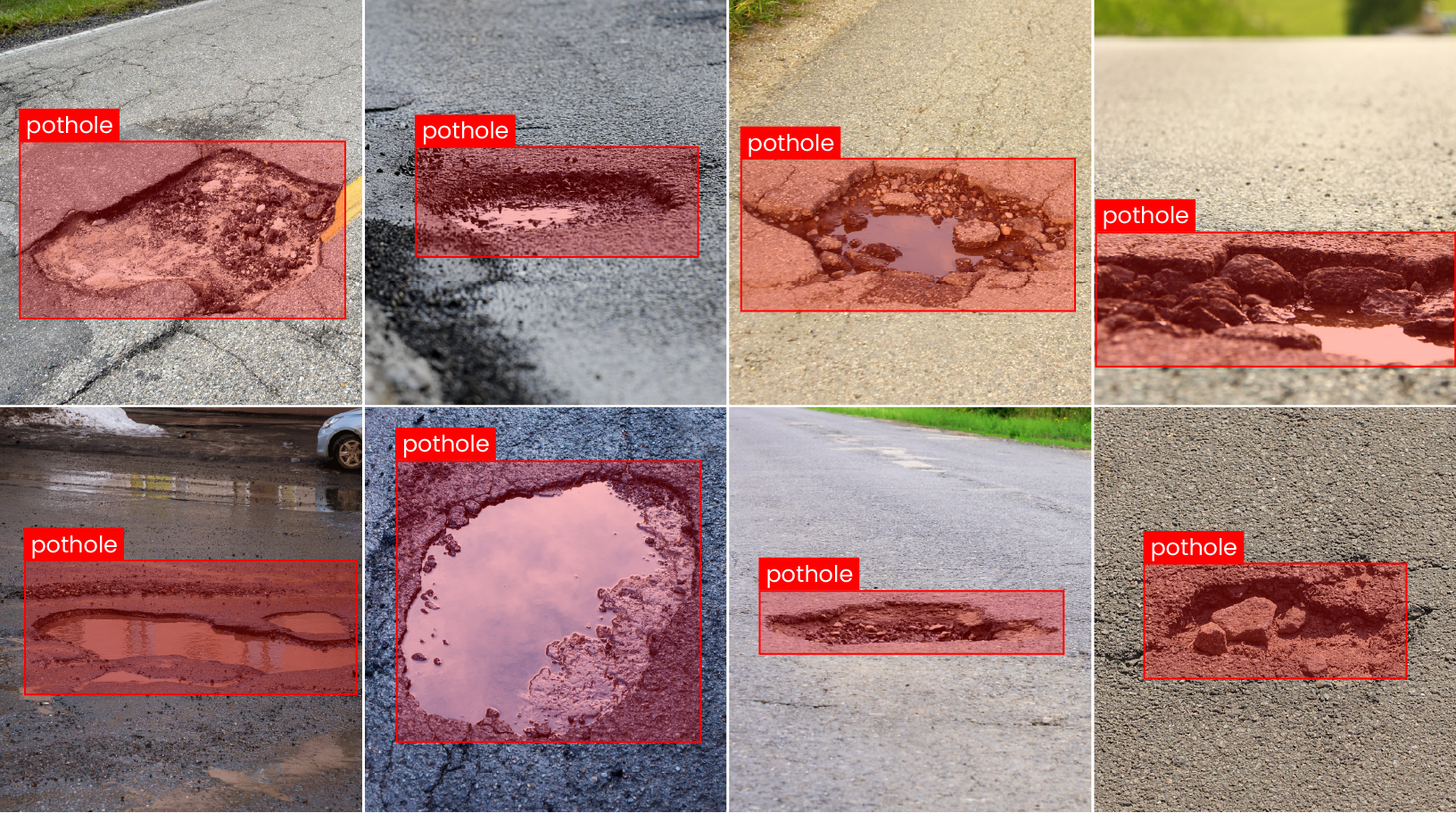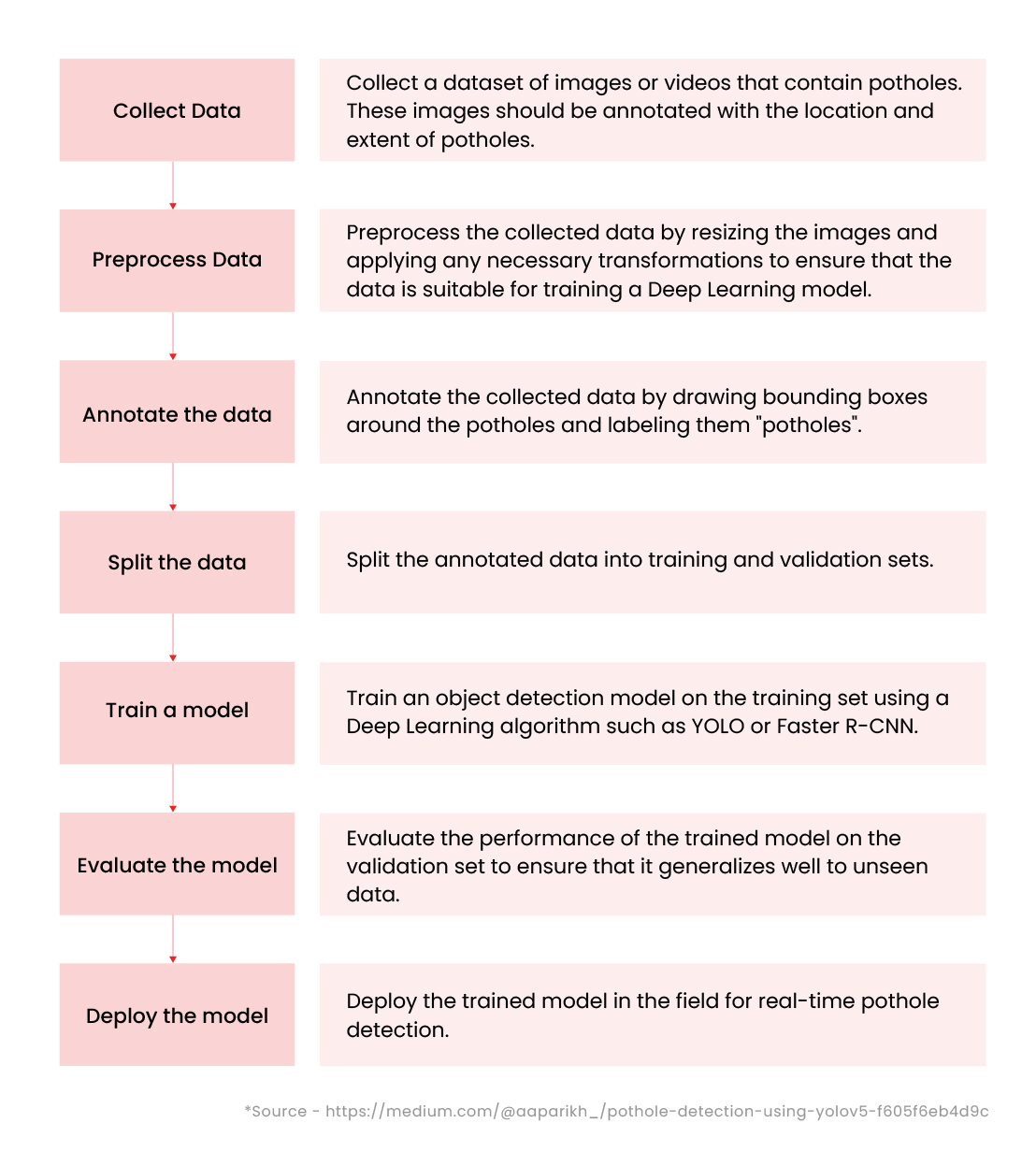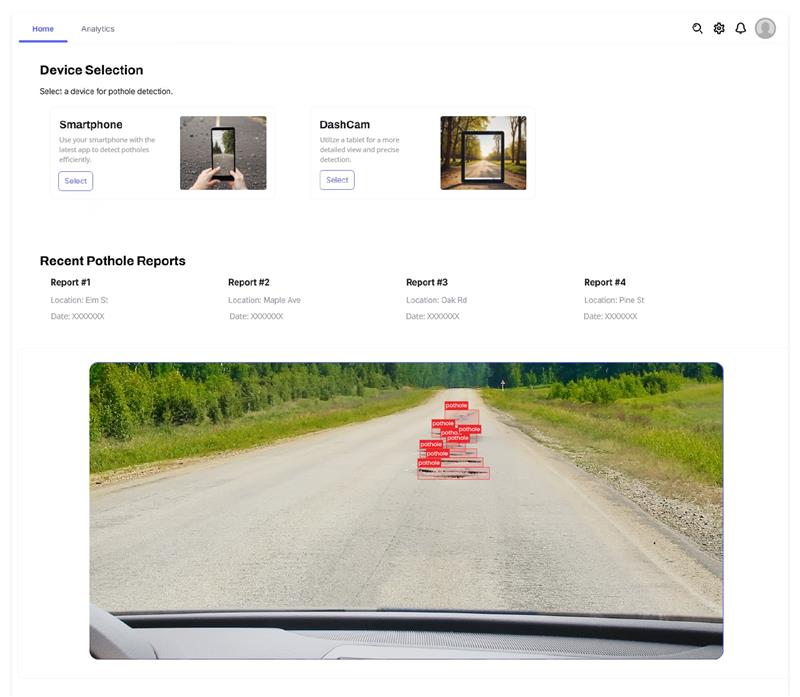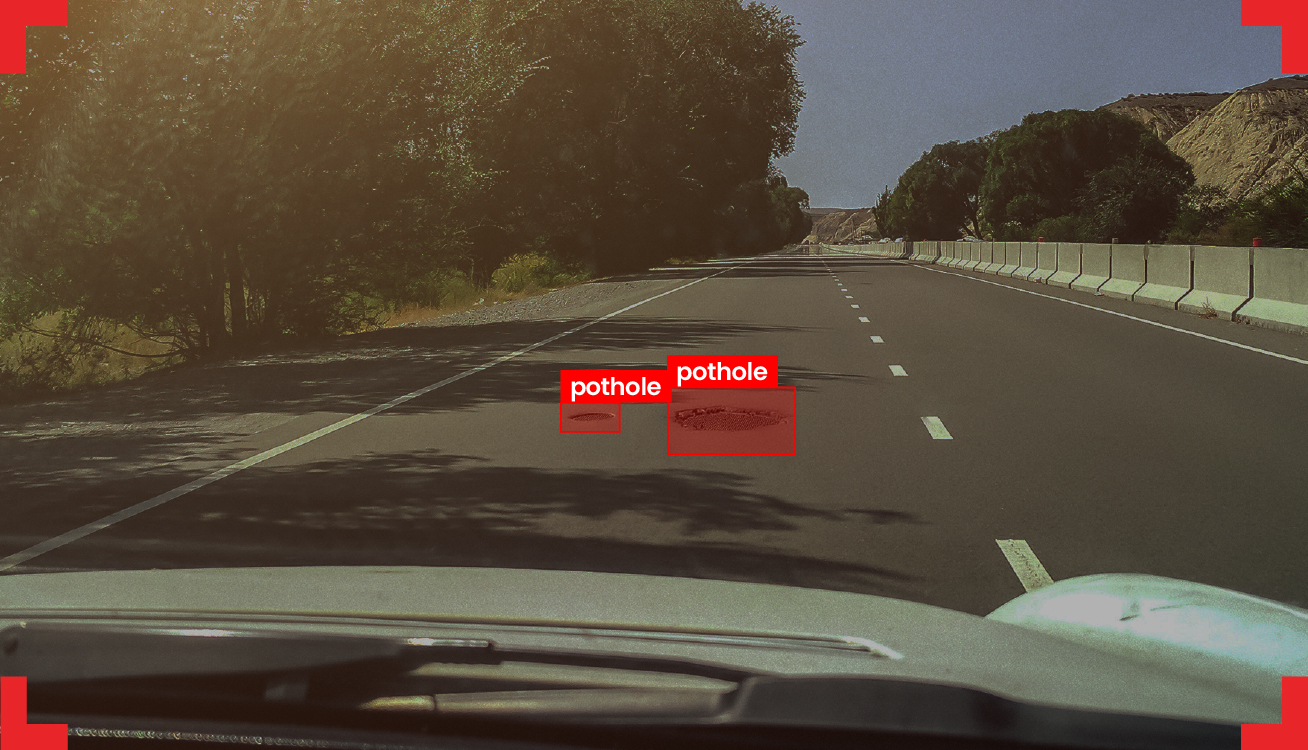Pothole Detection Using Computer Vision for Road Quality Management
- Vathslya Yedidi
- February 13, 2025
Potholes pose a serious and growing threat to public safety and infrastructure quality. These road defects cause significant vehicle damage, accidents, and even fatalities. Pothole-related vehicle repairs cost drivers approximately $3 billion annually in the United States. In New York City alone, nearly $138 million has been paid in settlements over six years due to pedestrian injuries and vehicle damage caused by road defects.
Studies indicate that potholes contribute to nearly 1% of all road accidents, with motorcyclists and cyclists facing even more significant risks. The impact of hitting a pothole can be equivalent to a collision at 35 miles per hour, leading to injuries ranging from whiplash to spinal damage.
As infrastructure ages and funding remains limited, the pothole problem worsens. In the UK, local authorities paid over £32 million in compensation for pothole-related injuries between 2017 and 2021, while pothole-related breakdowns hit a five-year high in 2022, with a nearly 20% increase in service calls.
Traditional manual inspections and high-cost 3D imaging methods remain inefficient. Pothole detection using Computer Vision is a scalable and cost-effective solution for municipal authorities aiming to improve road infrastructure.
This blog covers the inefficiencies of manual inspections, Deep Learning-based detection and its model selection, real-world applications, and benefits.
Solving Pothole Detection Challenges with Computer Vision
Detecting potholes in varying conditions poses significant challenges. Leveraging Computer Vision, powered by Deep Learning, offers the authorities a powerful solution for tackling these issues effectively.

- Inefficiencies in Manual Road Inspection: City road maintenance departments rely on labor-intensive inspections that are time-consuming and prone to errors. Vision AI improves pothole detection by analyzing road conditions more accurately, helping teams identify defects faster and prioritize maintenance repairs efficiently.
- Real-Time Detection for Safer Roads: Existing inspection methods fail to provide automatic pothole detection while driving in real time. Pothole detection with Vision AI enables continuous monitoring and rapid response for municipal authorities, reducing road hazards before they escalate.
- Variability in Road Surfaces and Environmental Conditions: Due to climate and road usage, potholes differ in size, shape, and material composition. Traditional detection systems struggle with these variations, but Computer Vision for pothole detection generalizes across different road types, ensuring reliable detection.
- Cost-Effective and Scalable Implementation for Cities: High-cost LiDAR and manual detection systems make city-wide pothole detection financially unfeasible. Deep Learning models provide governments with an affordable and scalable solution when deployed via standard vehicle-mounted cameras or smart infrastructure.
- Integration with Smart City Infrastructure and Predictive Maintenance: AI-driven pothole detection can integrate with municipal road maintenance planning, providing predictive maintenance strategies. This allows authorities to allocate budgets more effectively and prioritize repairs in high-risk areas before potholes lead to accidents or costly lawsuits.
Understanding Pothole Detection Using Deep Learning
Leveraging advanced image processing and predictive analytics, authorities can detect and address road damage before it worsens. Let’s see the process and how it works.

- Data Collection: Roadside cameras, vehicle-mounted sensors, and drones capture images and videos of roads. These inputs provide a diverse dataset covering lighting, weather conditions, and road types, ensuring the model learns from real-world scenarios.
- Data Labeling and Training: Collected images are annotated to distinguish potholes from other road elements like lane markings and debris. Proper labeling helps train Deep-Learning models to recognize damage patterns accurately, reducing false detections.
- Model Training and Optimization: Convolutional Neural Networks (CNNs) process labeled images to extract features such as edges, depth variations, and texture changes. Optimization techniques improve the model’s precision, enabling it to differentiate between actual potholes and similar-looking road irregularities.
- Real-Time Processing and Deployment: Once trained, the system is integrated into municipal monitoring and traffic surveillance networks. It detects potholes in real-time and triggers alerts, allowing authorities to address road damage promptly and enhance road safety.
- Predictive Maintenance and Continuous Learning: Beyond detecting existing potholes, Deep Learning models analyze historical data to predict where damage is likely to occur. This foresight enables timely repairs, preventing road deterioration and minimizing maintenance costs. Continuous learning mechanisms further refine detection accuracy by adapting to evolving road conditions.
Selecting the Best Model for Pothole Detection
Government agencies and city planners need AI models that balance accuracy, speed, and cost-efficiency. The most common architectures include:
- R-CNN: High accuracy but computationally expensive, requiring extensive processing time.
- Fast R-CNN: Improves processing time but still depends on region proposals.
- Faster R-CNN: Introduces Region Proposal Networks (RPN) for better speed but still not in real-time.
- Single Shot Detection (SSD): Balances speed and accuracy but struggles with more minor potholes.
- YOLO (You Only Look Once): Provides real-time detection at up to 45 frames per second, making it the best choice for automatic pothole detection while driving in innovative city applications.
Given the need for real-time pothole detection across large-scale road networks, YOLO-based AI systems provide the best balance between speed and accuracy for municipal implementation.
Key Applications of Computer Vision in Pothole Detection
Pothole detection using Computer Vision changes how cities manage road maintenance and transportation networks. Authorities and businesses can leverage this technology to enhance infrastructure resilience, optimize navigation, and improve road safety.
- Road Maintenance for Municipalities: Computer Vision-based pothole detection empowers municipalities to monitor road conditions in real-time, enabling faster interventions and more cost-efficient maintenance. This proactive approach reduces backlog repairs and optimizes resource allocation.
- Smart Navigation and Route Optimization: Uneven roads and potholes negatively impact traffic flow and vehicle efficiency. Navigation systems and transportation services can integrate pothole data to dynamically reroute vehicles, minimizing vehicle damage, improving fuel efficiency, and enhancing commuter experience.
- Enhanced Autonomous Vehicles and ADAS Systems: Self-driving and semi-autonomous vehicles rely on accurate road condition awareness. Integrating pothole detection allows these systems to anticipate surface irregularities, adjust speed and suspension settings, and select smoother routes, ensuring a safer and more comfortable ride.
- Data-Driven Infrastructure Investment: City planners can leverage pothole detection data to identify high-risk areas and allocate repair budgets strategically. This data-driven approach facilitates preventative maintenance, reduces long-term infrastructure costs, and improves road quality.

How Computer Vision for Pothole Detection Improves Road Quality Management?
Efficient road maintenance is critical for public safety and economic sustainability. Computer Vision for Pothole Detection provides a proactive approach to infrastructure management for several key reasons:
- Lower Road Maintenance Costs: Early detection prevents minor road damage from escalating into major repairs, saving municipalities significant costs. Addressing small potholes is far less expensive than fixing large ones that have developed over time.
- Enhanced Road Safety: Identifying and addressing road hazards quickly helps prevent accidents and vehicle damage, reducing the risk of injuries and costly liability claims.
- Streamlined Road Maintenance: Early detection eliminates delays in road inspections, enabling faster decision-making and quicker repairs. This improves efficiency and reduces traffic disruptions.
- Data-Informed Road Planning: Real-time insights into pothole locations and severity enable more effective road maintenance planning. This data-driven approach allows cities to optimize resource allocation, prioritize repairs, and predict areas prone to pothole formation, leading to proactive maintenance strategies.
Road maintenance is a growing challenge for municipalities, as aging infrastructure, budget constraints, and increasing traffic volumes lead to deteriorating road conditions. Pothole detection using Computer Vision offers a scalable, automated solution that improves road monitoring, reduces long-term maintenance expenses, and enhances public safety.
Government and businesses can make more innovative infrastructure investments, leveraging real-time insights and predictive analytics to ensure more sustainable and efficient road management. Implementing Computer Vision for pothole detection is a technological advancement toward safer roads, smarter cities, and cost-effective urban planning.
Get in touch to explore pothole detection using Vision AI solutions for better road quality management.

